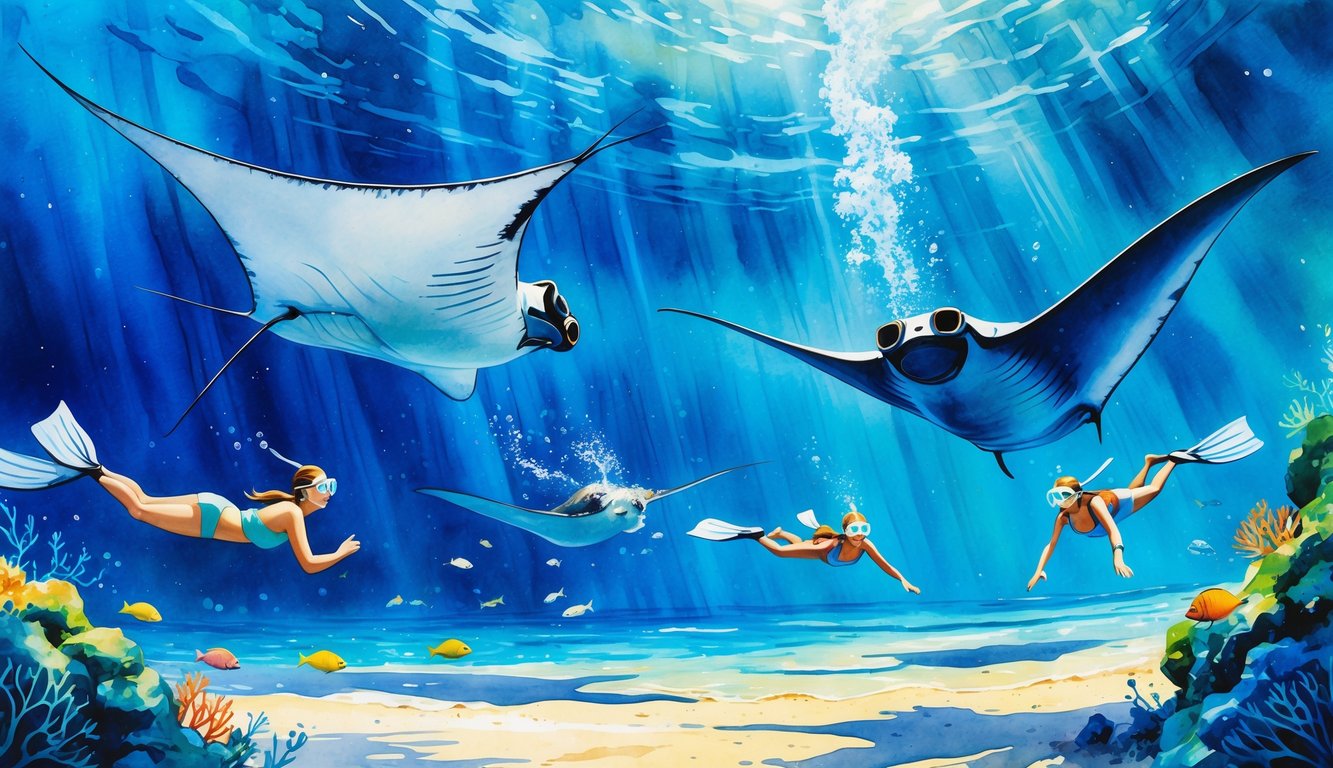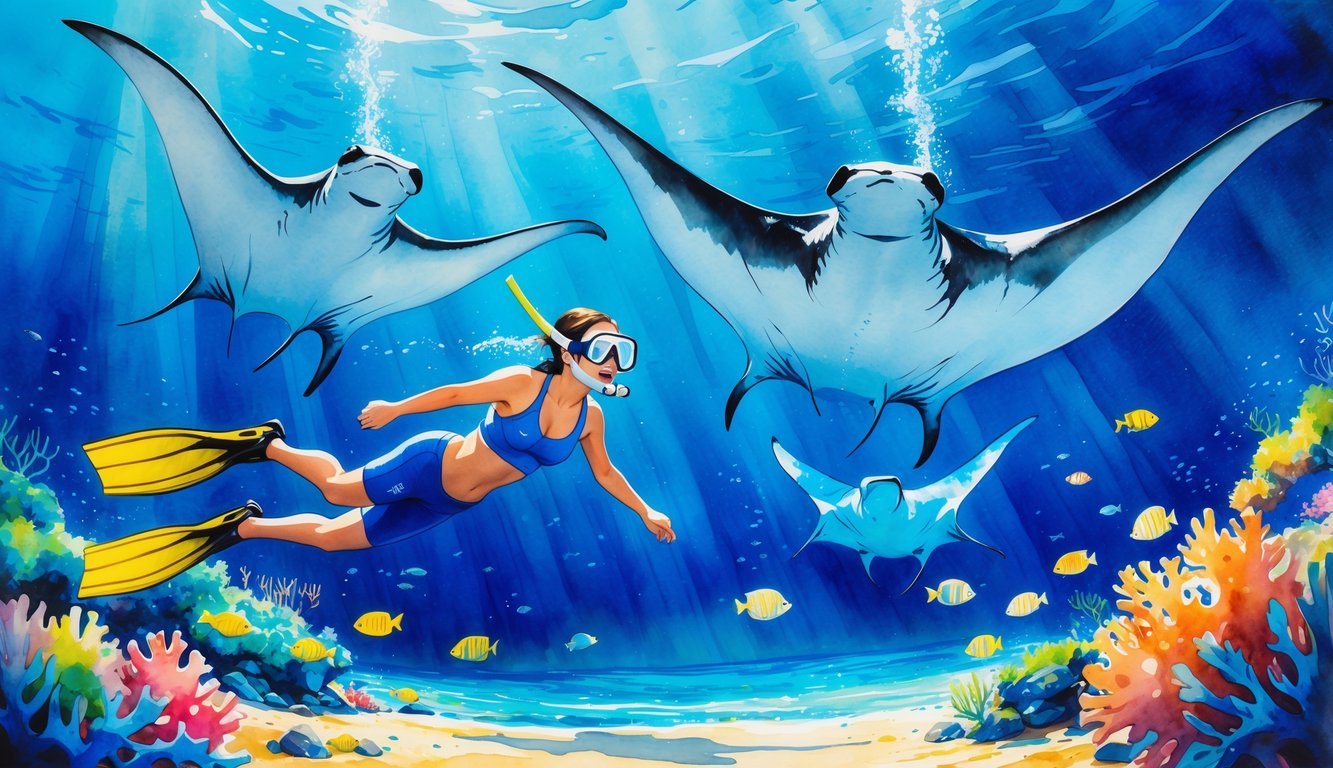Snorkeling with manta rays in Kona lets you see these gentle giants up close in a calm and memorable way. As the sun sets, lights in the water attract plankton, and manta rays arrive to feed.

Kona is one of the best places in the world to experience manta rays in their natural habitat at night.

The warm waters and clear visibility along the Kona coast make it perfect for this unique activity. Many tours, like those from Keauhou Bay to Manta Ray Village, keep group sizes small for a safe and personal encounter.
Watching manta rays glide just beneath the surface is peaceful and mesmerizing. Guided tours provide gear, safety instructions, and knowledgeable guides.
These tours focus on protecting the manta rays and the environment while giving guests a chance to enjoy one of Hawaii’s most memorable marine experiences.
Why Kona Is the Best Place for Snorkeling With Manta Rays
Kona offers calm waters, reliable manta ray sightings, and easy access to well-known snorkel locations. The area’s geography and marine life patterns give you consistent opportunities to see these large rays up close at night.
Unique Features of the Kona Coast
Mountains on Hawaii’s Big Island shelter the Kona Coast from strong trade winds. This protection keeps the water calm for most of the year, making it great for night snorkeling.
The coastline features steep underwater drop-offs close to shore. You can access deep water without a long boat ride.
Water clarity is excellent, with visibility often reaching 60–100 feet. This allows snorkelers to see manta rays clearly even at night.
Several local tour operators run small-group trips, reducing crowding and disturbance to the animals. Many tours follow guidelines to protect the manta rays and their habitat.
Manta Ray Village and Other Top Sites
Manta Ray Village, near the Sheraton Kona Resort at Keauhou Bay, is a popular spot for viewing. Here, lights placed in the water attract plankton, which brings in manta rays.
Manta Heaven, north of Kailua-Kona near the Kona International Airport, is another well-known location. This site offers deeper waters and different viewing angles.
Makaiwa Bay is less crowded but still provides regular sightings. Tour operators often pick the site based on weather and manta activity.
You can find more details on the best manta ray night snorkel in Kona from local travel guides.
The Role of Plankton in Attracting Manta Rays
Manta rays feed on plankton, which are tiny drifting ocean organisms. At night, lights from boats or floating platforms gather plankton near the surface.
The underwater landscape along the Kona Coast, especially at Manta Ray Village, traps plankton in certain areas. This makes manta ray sightings more predictable.
Kona has a resident population of over 450 manta rays, according to marine tour operators. These rays often return to the same feeding spots, giving snorkelers a high chance of encounters year-round.
Manta rays in Kona are used to the lights and human presence. They often swim in close circles, providing clear and safe viewing opportunities.
The Manta Ray Night Snorkel Experience
At night in Kona, bright underwater lights attract plankton, and manta rays come close to the surface. Snorkelers can watch these large, gentle animals glide and feed just a few feet away.
What to Expect During a Manta Ray Snorkel
Most tours start with a short boat ride to a manta ray gathering spot. Operators use floating rafts or platforms with lights that shine into the water.
These lights attract plankton, creating a feeding area for the manta rays. Snorkelers hold onto the raft or use flotation devices to stay in place while watching the rays swim below and around them.
The water is usually calm, but it can feel cooler at night. Wetsuits are often provided.
A typical trip lasts 1.5 to 2 hours, with about 30–45 minutes in the water. Many tours, like the Manta Ray Night Snorkel in Kona, welcome beginners and provide all necessary gear.
How Manta Rays Behave at Night
Manta rays feed by swimming slowly with their mouths open, filtering plankton from the water. At night, they become more active near the surface because the lights concentrate their food.
They often perform slow loops or barrel rolls to stay in the plankton-rich zone. This movement can bring them very close to snorkelers.
Each manta ray has a unique spot pattern on its belly, which researchers use to identify individuals. In Kona, some rays are well-known to local guides and have been seen for years.
Manta rays have no stinger or barb, unlike stingrays. They are harmless to people and do not bite.
Their size, with wingspans up to 12 feet, can be impressive but not dangerous.
Swimming With Manta Rays: Safety and Guidelines
Tour guides give a safety briefing before you enter the water. The most important rule is do not touch the manta rays because touching can remove the protective coating on their skin.
Snorkelers should stay flat on the surface and avoid diving down into the manta rays’ path. This helps the rays feed without disruption.
Keep your arms and legs close to your body when a ray passes nearby. Flash photography is often discouraged to avoid startling the animals.
Following the guide’s instructions keeps the experience safe and respectful for both people and manta rays. Many tours, such as the Kona Manta Ray Night Snorkel, emphasize protecting the animals and their habitat.
Choosing the Right Manta Ray Snorkel Tour

You can choose from several ways to see manta rays at night in Kona. Each tour offers different group sizes, departure points, and time in the water.
Tour operators provide gear, safety briefings, and guidance to make the experience safe and enjoyable.
Types of Manta Ray Snorkel Tours
Most snorkel tours in Kona start from Keauhou Bay or Honokohau Harbor. Keauhou Bay trips usually offer shorter boat rides to “Manta Ray Village,” while Honokohau departures may visit other viewing sites.
There are three main formats:
- Boat-based snorkel tours – Most common, with stable platforms and onboard amenities.
- Shore-entry snorkels – Less common, best for strong swimmers comfortable in ocean conditions.
- Manta ray night dives – For certified scuba divers who want to view mantas from the seafloor.
Some operators run small-group tours for a quieter experience, while others use larger boats that may cost less per person. Choose based on your budget, comfort, and preferred atmosphere.
You can compare operators through guides like the best manta ray night snorkel tours in Kona.
What’s Included With Most Tours
A typical manta snorkel package includes:
| Included Item | Purpose |
|---|---|
| Mask, snorkel, fins | Allows clear vision and efficient swimming |
| Wetsuit or shorty | Keeps guests warm in cooler night water |
| Flotation device | Helps maintain position on the surface |
| Underwater lights | Attract plankton, which bring in manta rays |
| Guide/instructor | Ensures safety and explains manta behavior |
Most tours provide a safety briefing before you enter the water. Some offer hot drinks or light snacks after the swim.
Photography services may be available for an extra fee. If you bring your own gear, check if it meets the operator’s safety standards.
Tips for Booking Your Adventure
Book your tour early, especially during busy travel seasons. Many tours fill up days in advance.
Check cancellation policies in case of poor weather or low manta activity. Some operators offer a free rebooking if no mantas appear.
Read recent guest reviews for details on group size, guide quality, and comfort. Comparing companies, such as those in this Kona manta snorkel guide, can help you find the right trip.
Confirm departure times, as sunset and night tours vary in length. Arrive early to check in, get gear fitted, and receive instructions before heading out.
Essential Gear and Preparation for Your Snorkel

Having the right equipment and knowing how to use it helps make your manta ray night snorkel safe and enjoyable. Good preparation reduces stress, improves comfort, and protects the marine environment.
Snorkel Gear and Equipment
For a manta ray night snorkel, you need a mask, snorkel, and fins. A well-fitting mask prevents leaks and keeps your vision clear.
A dry-top snorkel helps reduce water intake, especially in choppy conditions. Fins should fit snugly and allow smooth kicks without strain.
Many operators provide gear, but some recommend bringing your own for comfort and hygiene. Manta Ray Advocates notes that personal gear can improve your confidence in the water.
Other useful items include:
| Item | Purpose |
|---|---|
| Wetsuit or rash guard | Keeps body warm during night swims |
| Snorkel vest | Adds buoyancy and visibility |
| Underwater light | Helps see manta rays and surroundings |
Test all gear in shallow water before the trip to ensure it fits and works properly.
Preparing for a Nighttime Ocean Adventure
Night snorkeling in Kona gives you a unique view of manta rays. You need to be extra prepared because the ocean feels different after dark.
Artificial lights affect how well you can see underwater. Many tours give pre-dive briefings to explain safety and group signals.
Guides show you how to stay close to the group. They also teach you how to position yourself so manta rays can approach without disturbance.
Eat a light meal before boarding. Heavy food can make you uncomfortable in the water.
Wear a swimsuit under your wetsuit for quick changes. Bring a towel and a change of clothes for after the snorkel.
Responsible and Eco-Friendly Snorkeling
Manta rays are gentle filter feeders, but human behavior can harm their safety. Swimmers should avoid touching the animals because contact can damage their protective coating.
Stay horizontal at the surface. Keep fins away from the rays.
Follow the guide’s instructions on where to float and how to move. This helps the manta rays feed naturally under the lights.
Choose operators who follow responsible wildlife interaction guidelines, such as those listed by Manta Ray Night Snorkel Hawaii. These tours limit group size, avoid chasing animals, and use eco-friendly lighting.
Secure loose gear. Use reef-safe sunscreen to help protect the manta rays’ habitat.




